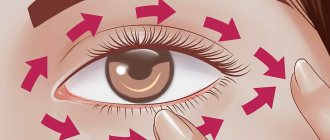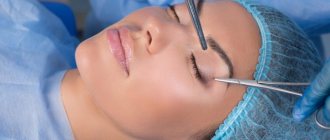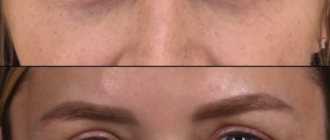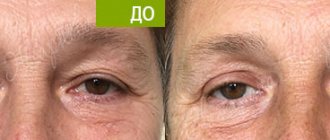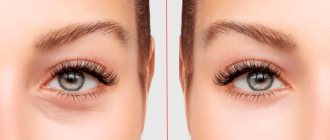One of the most common rejuvenation methods in plastic surgery is blepharoplasty. It allows you to correct many appearance flaws associated with both age-related changes and certain physiological characteristics.
Eyelid surgery is one of the most complex types of facial surgery. Not only the aesthetic effect that you get after recovery, but also many functional features depends on the qualifications of the surgeon. After all, the eyes, in the area around which the surgeon works, are a complex, delicate and very sensitive organ.
There are many myths regarding blepharoplasty, and patients who decide on the need for such an intervention, as a rule, do not go to the surgeon for their first consultation, but to the Internet, where they get information about all sorts of dangers that the operation poses. Our clinic specialists provide qualified answers to your questions.
Can vision deteriorate after blepharoplasty?
No. Plastic surgery of the upper eyelids, on the contrary, will improve vision - in the event that drooping eyelids interfere with normal vision.
Brief visual disturbances after surgery are normal and are associated with swelling at the surgical site. It goes away a few days later, when the process of active recovery begins. Sometimes in the first 2-3 days, patients notice that they see double, the picture is unclear - this is also a short-term phenomenon that is considered normal.
Eyelid surgery and local anesthesia
If you decide to undergo blepharoplasty, this does not mean that the possibility of general anesthesia is automatically excluded in your case. Avoiding anesthesia during surgical correction of the eyelids is possible only with a technically simple and small-scale operation, for example, with upper blepharoplasty. Of no small importance is the moral state of a person, who must be psychologically prepared to undergo surgery while conscious.
Speaking about the advantages of using local anesthesia during plastic surgery on the eyelids, it is worth mentioning the following points:
- extremely low risk of developing possible complications, since more “heavy” drugs are used during anesthesia
- the patient can move his eyelids and open and close them at the request of the doctor, which makes it easier for the latter to carry out the operation
- the risk of under- or over-correction of the eyelids is reduced
- opportunity to go home on the day of surgery
But since plastic surgery, regardless of the level of technical complexity, is a surgical intervention, blepharoplasty under local anesthesia has its pitfalls. So:
- During the operation, the patient will have high blood pressure due to nervous tension. This phenomenon in itself is not dangerous, but it will be less convenient for the doctor to work
- there is still a risk of allergic and other reactions to drugs
- Many surgeons fundamentally work only with patients under anesthesia, so as not to be distracted by anything during the operation
Should I be afraid of noticeable scars after blepharoplasty?
Scars remain after any surgery. Blepharoplasty is no exception. But for others, these scars will be completely invisible, because:
- firstly, they are done in areas that are located in the natural fold of the eyelid,
- secondly, the scars are very thin, since modern suture material is used for processing,
- thirdly, if you properly care for the operated area, no complications can be expected.
True, in some cases the individual characteristics of the skin are such that the stitch marks are slightly lighter than the main skin tone.
Lower blepharoplasty is often done using a transconjunctival method through a mini-incision on the inside of the eyelid using a laser. In this case, there will be no scar at all.
The essence of the procedure
The main reason for the appearance of a “bag”, or more precisely, a hernia under the eyes, is a deficiency of collagen fibers in the thickness of the lower eyelid. This change in the 3D framework of the skin occurs with age in some people, and in others as a result of genetic predisposition.
A lack of collagen causes the lower eyelid to stretch. By sagging, the skin creates negative pressure, and it attracts fatty tissue, which is located around the eye and is designed to protect it from injury. Fat cells do not appear immediately under the lower eyelid. First, the vacuum should cause micro-holes to form in the membrane between the skin and the underlying tissue.
The laser used to perform non-surgical blepharoplasty is a special beam of light. Sent to the lower eyelid in microbeams, it evaporates columns of tissue in the skin. This activates fibroblast cells located along the perimeter of the evaporated microcolumns. Fibroblasts synthesize new collagen fibers, and the skin of the lower eyelid tightens. Along with infraorbital hernias, the wrinkles surrounding the eye also disappear: “crow’s feet”, nasolacrimal creases. Warming up the tissues that occurs during the procedure improves local blood circulation and lymphatic drainage, and the evaporation of fluid from the epidermal cells erases the pigmentation present there.
Is it true that after blepharoplasty the eyelids look “lifeless” and the lower eyelid may sag?
It all depends on the skill and experience of the doctor. Our surgeon has performed many operations in recent years and this experience is the best guarantee that blepharoplasty will be performed with complete preservation of the normal condition of the eyelids.
Only excess skin is excised. The doctor will not cut off too large fragments of skin; there is no need to be afraid of this. Immediately after surgery, the appearance may actually be a bit scary - as there will most likely be some bruising and swelling. Because of the same swelling, at first it may seem that the eyelid is “tight” and is in an unnatural position. But these sensations pass as soon as the adaptation period ends and the swelling disappears.
Benefits of laser blepharoplasty
- The non-surgical procedure is performed in an outpatient setting, unlike surgery.
- The manipulations are painless, since they are performed using anesthetic gels.
- During one procedure, four to five effective innovative laser techniques are combined.
- The recovery period lasts 48 hours.
- The tangible visual effect of non-surgical blepharoplasty is noticeable a month after the first session and increases over time; subsequent procedures enhance and consolidate the result.
- The procedure can be done regardless of the time of year.
- The price of non-surgical laser plastic surgery is relatively low.
Preparation for the procedure
The non-surgical technique of laser blepharoplasty of the upper and lower eyelids, despite positive reviews and reasonable prices in Moscow clinics, is not applicable in all cases, so a free consultation with our doctor is first required. Our clinic specialist will determine the presence of any possible contraindications and, if they are absent, will schedule a day for the procedure. There is no need to prepare specially for it or take tests.
Indications for the procedure for rejuvenating the skin around the eyes
- Flabbiness and thinning of the dermis in the eyelid area.
- Drooping of the upper eyelids due to excess or decreased skin turgor.
- Formation of the nasolacrimal groove.
- Formation of wrinkles on the skin around the eyes.
- Scars and other skin defects in the paraorbital area.
- Small hernias, swelling and swelling in the eyelid area.
- Wrinkles and sagging skin around the eyes.
Contraindications
- Inflammatory processes on the skin of the eyelids.
- Infectious diseases.
- Bronchial asthma, in severe cases.
- Autoimmune diseases.
- Malignant tumors.
How is non-surgical blepharoplasty performed?
The laser blepharoplasty procedure is carried out in several stages:
STAGE 1: REJUVENATION FROM INSIDE THE EYELIDS (Fotona Smooth technology)
The eyes are protected with special intraocular steel caps using an anesthetic gel. The mucous membranes of the lower and upper eyelids (conjunctiva) are treated with an erbium laser in the fractional Smooth - coagulation (heating) mode.
The effect of laser radiation precisely through the conjunctival mucosa, taking into account the chromophore, allows you to increase the temperature of deep-lying tissues without absolutely damaging the mucosa!!! and those structures to which heat will be directly transferred. At the same time, the volume of adipose tissue in the conjunctival sac is reduced, deep structures are rejuvenated by stimulating collagen renewal processes in all layers of eyelid skin.
STAGE 2: DEEP REJUVENATION OF THE SKIN AROUND THE EYES (Frac3 technology)
Stage of deep dermal laser treatment on the area around the eyes and the entire middle third of the face, including the skin of the forehead. This stage of the procedure is performed using a neodymium laser (Fotona Nd:YAG). The integrity of the skin is not compromised. The purpose of this stage of the procedure is to launch the processes of neocollagenogenesis, reconstruction of tissues of the upper third of the face, elimination of venous stagnation, pigmentation, improvement of turgor and skin tone.
STAGE 3: REVITALIZATION OF THE SKIN AROUND THE EYES (Piano technology)
A neodymium laser (Nd:YAG) in Piano mode evenly and painlessly heats not only the middle but also the deep layers of the dermis. This effect produces a powerful effect of revitalizing, toning and tightening tissue.
STAGE 4: LASER GRINDING OF THE SKIN AROUND THE EYES IN SMOOTH MODE
An erbium laser (ER:YAG) is applied to the skin of the upper and lower eyelids and the entire middle third of the face, as well as the skin of the forehead (to tighten the upper eyelid). Thus, powerful lifting is ensured, skin turgor and tone are restored, wrinkles are smoothed out, and pigmentation is eliminated.
ADDITIONAL STAGE 5: FRACTIONAL LASER GRINDING OF THE SKIN AROUND THE EYES
At the fifth stage of laser blepharoplasty, the skin of the lower and upper eyelids is treated with fractional laser beams in ablation (evaporation) mode, damaging the skin surface in order to reduce the skin flap, noticeably tighten sagging eyelids and radically rejuvenate the tissue.
Recovery period after the procedure
The recovery period lasts on average 48-72 hours. The skin looks reddened and swollen. If an additional 5th stage was included in the procedure protocol, the rehabilitation period can last up to 5 days.
To achieve optimal and long-lasting results, it is necessary to complete a course of two or three procedures at 40-60-day intervals. How much laser blepharoplasty costs depends on this, but we note that our clinic regularly offers promotions for the procedure.
What happens after laser eye area rejuvenation?
- Excess skin is reduced and the upper eyelid is lifted
- Bruises and blueness under the eyes are reduced by eliminating venous stagnation
- Smooth out bags under the eyes
- Removes wrinkles around and under the eyes
- And all this in one multi-stage procedure with rehabilitation of 2-5 days
Today, the SmoothEye™ laser blepharoplasty technology has no analogues in the laser rejuvenation market and has already established itself as the most revolutionary non-surgical technique of the 21st century in the leading beauty salons of the world.
Photos of results before and after non-surgical laser blepharoplasty
Is it true that blepharoplasty is very painful?
Any operation is an intervention in the body, and of course, one cannot expect pleasant sensations from it. It will be somewhat unpleasant for you during blepharoplasty. But we use exclusively high-quality painkillers that will reduce discomfort to a minimum.
The skin of the eyelids is indeed a very sensitive area. After the operation, there will definitely be pain in the places where the stitches are placed. But this, firstly, indicates that everything went correctly, and secondly, it can be relieved with painkillers. Discuss the choice of drug with our specialist - he will help you choose the most suitable remedy.
Some of our patients note that the healing sutures itch quite a lot. This can also cause some discomfort, but like the previous described effects, it passes relatively quickly.
Who can benefit from blepharoplasty? Indications
Blepharoplasty may help if you have:
- Excess fat deposits on the upper or lower eyelid that cause puffiness
- Weak skin of the upper eyelid that hangs over the eyeball
- Bags and dark circles under the eyes
- Sagging and age-related changes in the lower eyelids
- Wrinkles in the paraorbital area
- The desire to change the shape and shape of the eyes, for example - Europeanization of Asian eyes
In the presence of severely drooping outer corners of the eyebrows, it is more effective to combine upper eyelid blepharoplasty with a forehead and eyebrow lift.
Contraindications
The main contraindications are the same for any surgical intervention. This:
- any acute illness
- acute and chronic diseases of the eyes, lacrimal glands and ducts
- blepharospasm
- conjunctivitis
- bleeding disorder
- blood diseases
- chronic disease in the acute stage
- diabetes
- venereal diseases
You can find out the full list of contraindications during a free consultation.
Laser blepharoplasty of the upper eyelids
Laser blepharoplasty is performed to reduce the amount of excess skin and fat in the upper eyelid area, thereby eliminating sagging and puffiness in this area.
The method has virtually no differences from the traditional one, with the exception of the use of a laser instead of a scalpel during the operation.
The surgeon makes an incision in the natural crease of the upper eyelid, then removes excess skin, muscle and fat, then closes the incisions with thin sutures that leave invisible scars.
Video of upper blepharoplasty surgery. Surgeon Zharkova S. N.
CHTA Academy courses
The Academy of Additional Professional Education CHTA has developed advanced training and professional retraining courses specifically for medical workers in the field of cosmetology. They will help you master a new specialty or develop the qualifications of an existing one.
Distinctive features of training at the Academy
The courses are developed on the basis of distance learning and comply with all standards of domestic legislation. The study of the theoretical component takes place according to an individual program, which provides for conducting the educational process remotely.
Course participants do not need to attend lectures or combine study and work activities - all they need is an Internet connection. Today, this is the most accessible and advanced training format, because distance e-learning technologies are used in all leading universities in the country.
All courses are aimed at the most effective acquisition of new competencies and skills of the student in the field of cosmetology. This helps in solving emerging professional problems and achieving goals in the future.
After successfully completing the course and passing the certification test, trained/retrained specialists in the field of “Cosmetology” receive a certification document that officially confirms advanced training or retraining (depending on the chosen course).
Requirements for students
To attend these courses there is no need to meet any special requirements, you only need to have a specialized education. Therefore, training is available to almost anyone.
How to choose the right cosmetologist?
First of all, when choosing a cosmetologist, you need to pay attention to his education. A professional cosmetologist will always be able to provide the patient with a diploma confirming receipt of specialized medical education or relevant professional retraining. You should carefully read all documents and verify their authenticity in person.
In addition, every self-respecting specialist undergoes regular advanced training courses for cosmetologists, which allow them to continue working in this field. After all, it is not enough to form basic knowledge and acquire basic skills in the field of cosmetology; it is necessary to periodically update and expand them in every possible way, in accordance with the modern technological equipment of medical institutions and the norms of labor legislation of the Russian Federation.
